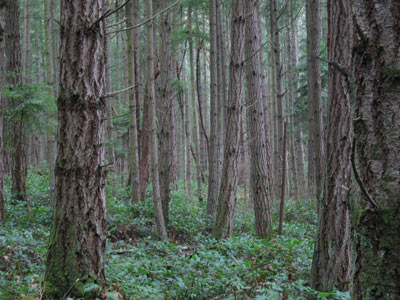A look at the landscape in next-generation non-food biofuels.
BY PHIL DAQUILA

Forests are one of the primary resources for the cellulosic biomass that can be converted to transportation fuels and electricity. Dedicated energy crops of fast-growing trees are being cultivated, and remnants from logging such as limbs, tree tops and stumps are being collected for this use. (Photo by Tom Harpel)
What is biomass?
Biomass refers to plant material that can be harvested for energy. Any plant can be used for its biomass.
If any plant can be used for energy, why is corn the most common?
Corn was used to make nearly all of the eight billion gallons of ethanol that the U.S. produced in 2008. Corn was part of the first generation of plants used to create biofuels because it could be turned into ethanol using technology that already existed to convert plant starch to alcohol.
What can we use besides corn?
Second-generation biofuels are now being produced from crops that can’t be used for food—plants such as giant cane (Arundo donax) and other perennial grasses. Selectively harvested biomass from forestry materials is also being converted into forms of bioenergy.
Which of those second-generation sources are most likely to be environmentally and economically sustainable?
The future of biomass energy will likely come from a variety of feedstocks situated in the regions most suited to growing each of them. Expect to see a patchwork of fast-growth trees and grasses spread around the country, says John Erickson, assistant professor and environmental agronomist at the University of Florida.
How many acres will be needed to meet the demand for alternative fuels?
The Energy Independence and Security Act of 2007 requires that by 2022 the United States use 36 billion gallons of renewable fuels, of which 16 billion gallons are supposed to come from cellulosic sources such as trees, grasses, weedlike energy crops and non-edible parts of plants.
The total acreage of giant cane needed to create 16 billion gallons of ethanol—assuming a yield of 13.4 tons of giant cane per acre and 91 gallons of ethanol per ton of biomass—is 13.1 million.
To completely replace the annual U.S. gasoline consumption would require about 170 million acres of Arundo, or just under half a football field per person per year. By comparison, corn is currently grown on about 87 million acres in the United States.
Why aren’t more biofuels on the market now?
The technology needed to turn cellulosic material into biofuel is still in the early stages of development. Cellulosic ethanol differs from ethanol in that it requires an extra step called cellulosis, which is the breaking down of cellulose into sugars. According to Norman Smit, the director of communications and education at the Biofuels Center of North Carolina, until there is a conversion process that has proven economic models, farmers will not be persuaded to grow energy crops.

